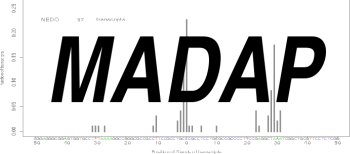MADAP is a flexible clustering tool for the interpretation of one-dimensional genome annotation data mapped onto complete or partial genome sequences. Such data might consist in counts, probabilities, or intensities and be obtained from cDNA and tag sequencing protocols to map the 5' and 3'ends of mRNA, from ChIP-chip analysis, or from genome-wide SNP-typing used in genotype-phenotype association studies. MADAP identifies groups of data corresponding to one or several genomic sites, and estimates the volume and extension of such groups (clusters).
Input: set of integer numbers, typically representing genomic positions. These numbers can occur multiple times, according to the strength of a measure at a given genomic site. The MADAP web-server accepts data in different formats, including gff files (see below).
Processing: MADAP models one-dimensional input data by a set of clusters defined by center and range, which have sufficient support from the data and which are compatible with constraints defined by the user.
Output: clustering results are provided in graphical and tabular form, accompanied with descriptions of iteration steps of the algorithm.
Source code: MADAP is also available as a stand-alone program at : ftp. A more detailed description is available here.
Publication: Schmid CD, Sengstag T, Bucher P and Delorenzi M. (2007) MADAP, a flexible clustering tool for the interpretation of one-dimensional genome annotation data. Nucleic Acids Res, 35, W201-205 (PMID: 17526516).
Last update 27 Sep. 2012
